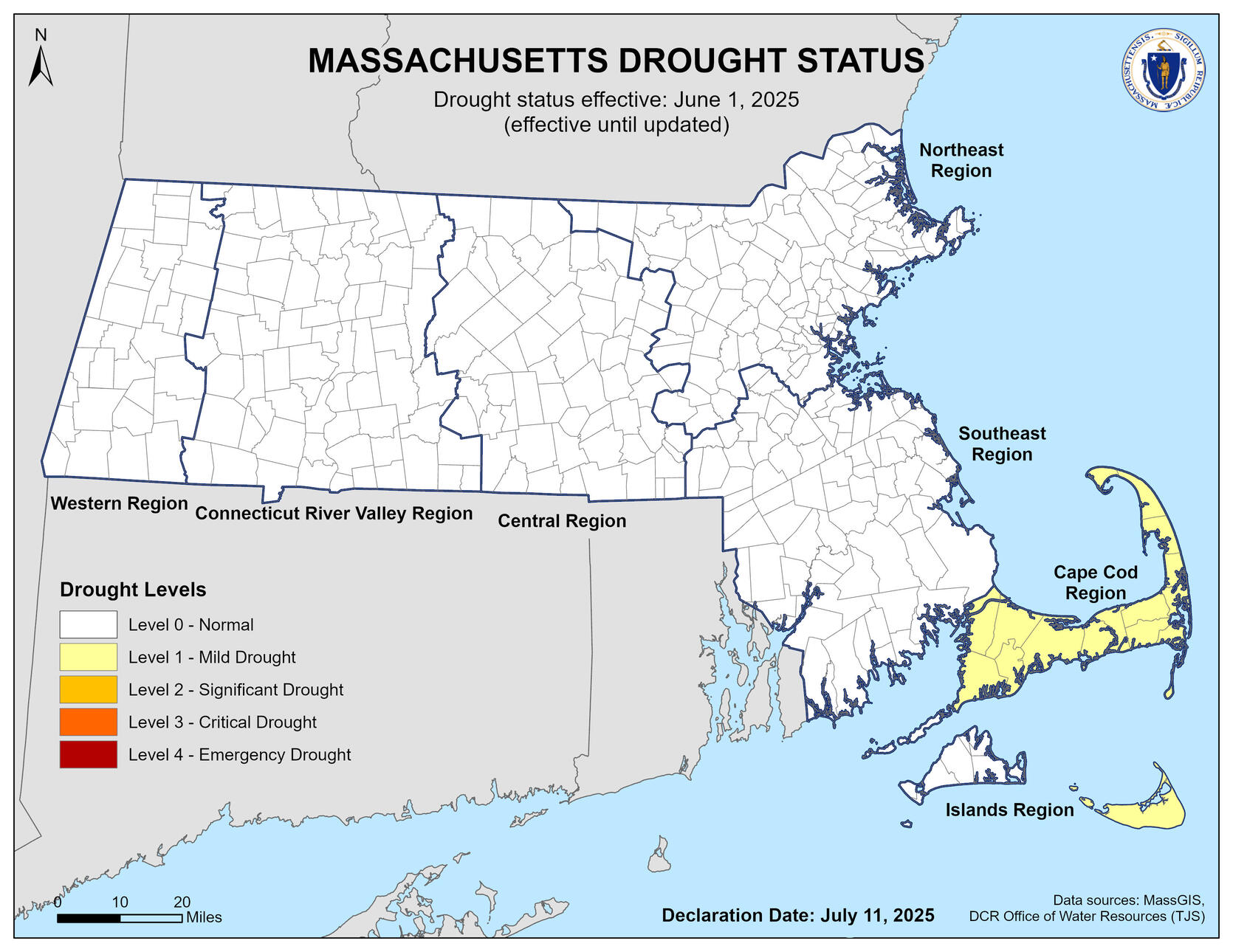- Executive Office of Energy and Environmental Affairs
- Drought Management Task Force
Media Contact
Aisha Revolus, Communications Manager

BOSTON — Today, Energy and Environmental Affairs (EEA) Secretary Rebecca Tepper declared theCape Cod Region has been downgraded to a Level 1-Mild Drought after being at Level 2-Significant Drought since January. In the Islands Region, Dukes County has been downgraded to Level 0-Normal Conditions, while Nantucket County remains at Level 1-Mild Drought. The Southeast, Connecticut River Valley, Western, Central, and Northeast Regions remain in Level 0-Normal Conditions.
Despite a somewhat dry June, rains over the last several months have provided relief. However, additional precipitation is needed to restore water systems, particularly groundwater levels on the Cape and Nantucket. As outlined in the Massachusetts Drought Management Plan, a Level 1 – Mild Drought requires detailed monitoring of drought conditions. These levels also require ongoing coordination among state and federal agencies to implement drought response actions such as water use restrictions. Additionally, engagement with municipalities, including local Boards of Health, is essential. This includes providing technical outreach and assistance to water suppliers and affected municipalities.
During June, below-normal precipitation was observed across Massachusetts. Most regions of the state received between 1 and 3 inches of rainfall. Additionally, groundwater levels in the past month were normal across the state, except for the Southeastern, Cape Cod, a few locations in the Northeast, and the Islands regions, where most wells were observed below normal. Although streamflow conditions were mainly normal, most gages experienced a decrease in their flow percentile during June, due to below-normal precipitation and higher temperatures. Over the past three months, precipitation has been well above normal, with recent rain improving overall streamflow and reducing fire risk across the state.
The Drought Management Task Force (DMTF) collected data from August 2024 through June 2025. Residents can report dry environmental conditions and submit photos to help monitor the situation Massachusetts Water Impact Reporting. Additionally, a FAQ is now available for questions regarding the current drought status and water conservation.
The Massachusetts Department of Environmental Protection (MassDEP) will continue to assist communities in managing their water systems. The Massachusetts Water Resources Authority (MWRA) water supply system is not experiencing drought conditions.
Below are recommendations for communities and individuals living and working within a Level 1 – Mild Drought, including those utilizing a private well. Residents and businesses are also asked to check with their local water system in case more stringent watering restrictions are in place.
For Regions in Level 1 – Mild Drought
Residents and Businesses:
- Minimize overall water use;
- Limit outdoor watering to one day per week from 5:00 p.m. to 9:00 a.m., or less frequently if required by your water supplier;
- Plant only local and drought-resistant species;
- Fix indoor leaks, such as from toilets, faucets, and showers, which result in more than 60 percent of indoor use;
- For larger buildings and businesses, conduct water audits to identify areas of leaks and potential water conservation opportunities;
- Minimize lawn sizes; and,
- Harvest rainwater for outdoor watering.
Communities/Municipalities:
- Establish a year-round water conservation program that includes public education and communication, taking advantage of the state’s library of outreach materials;
- Provide timely drought and water conservation information to residents and businesses;
- Check emergency inter-connections for water supply; and,
- Develop a local drought management plan (learn more Drought Planning Guidance).
State agencies will continue to closely monitor and assess conditions across the state, coordinate any needed dissemination of information to the public, and help federal, state, and local agencies prepare additional responses that may be needed in the future. The Drought Management Task Force will meet again on Wednesday, August 6th, at 10:00 am. For further information on water conservation and what residents can do, visit the EEA’s drought and water conservation pages.
###
